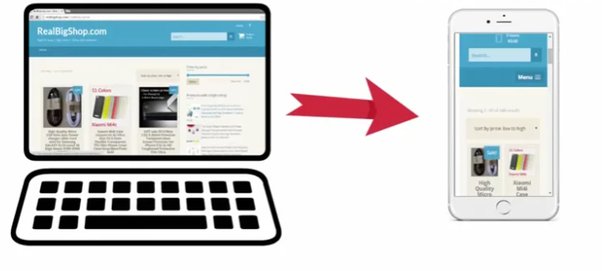Transform Website to Mobile App Fast

In today’s digital age, having a mobile app for your business is no longer a luxury but a necessity. With more and more people relying on their smartphones for information and services, it’s crucial to transform your website into a mobile app to stay competitive and reach a wider audience. But how can you do it quickly and efficiently?
In this blog post, we will guide you through the process of transforming your website into a mobile app fast. We’ll discuss the importance of understanding the need for this transformation and choosing the right tools and platforms. Additionally, we’ll provide a step-by-step guide to help you execute the transformation seamlessly.
Choosing the right tools and platforms is a critical aspect of the transformation process. We’ll delve into why it’s important to make the right choices and compare popular web to mobile transformation tools. Furthermore, we’ll help you decide whether you should choose iOS, Android, or both platforms for your mobile app.
Once you’ve selected the tools and platforms, we’ll walk you through the step-by-step process of transforming your website into a mobile app. From understanding your website’s core functions to implementing them in a mobile format and ensuring functionality and user experience, we’ll cover it all.
Mobile optimization is key to the success of your mobile app. We’ll discuss the importance of optimizing your app for better performance and provide you with valuable tips to improve its speed and responsiveness. Additionally, we’ll guide you on how to monitor and update your app to ensure it stays up-to-date and meets the evolving needs of your users.
Lastly, we’ll explore the various strategies you can employ to market your new mobile app. From planning your launch strategy to promoting your app on social media and other platforms, we’ll help you create buzz and generate downloads. We’ll also provide insights on engaging your users and encouraging them to use and recommend your app to others.
Transforming your website into a mobile app fast is essential to stay relevant in today’s mobile-first world. So, let’s dive in and learn how you can make this transformation efficiently and effectively.
Understanding the Need to Transform Your Website into a Mobile App
In today’s digital landscape, mobile devices have become an integral part of our lives. People are increasingly relying on smartphones and tablets to access information, shop, communicate, and perform various tasks on the go. As a result, businesses need to adapt to this mobile-first mindset and ensure they provide a seamless and optimized user experience across all platforms.
Here are some key reasons why transforming your website into a mobile app is crucial:
Mobile Dominance: Mobile devices have surpassed desktops as the preferred method of accessing the internet. Studies show that the majority of internet traffic comes from mobile devices. By transforming your website into a mobile app, you can tap into this massive mobile user base and increase your reach.
Enhanced User Experience: Mobile apps offer a more streamlined and intuitive user experience compared to websites. With a mobile app, you can leverage native features like push notifications, location-based services, and access to device hardware, providing a more personalized and engaging experience to your users.
Improved Performance: Mobile apps are designed to work efficiently on smartphones and tablets, resulting in faster load times and smoother navigation. Users expect quick and responsive experiences on their mobile devices, and a well-optimized app can deliver just that.
Offline Accessibility: Unlike websites that require an internet connection, mobile apps can provide certain functionalities even in offline mode. This is particularly beneficial for businesses that offer services or content that users may want to access on the go, even without an internet connection.
Brand Presence and Recognition: Having a dedicated mobile app for your business enhances your brand presence and visibility. It creates a direct channel of communication with your users and reinforces your brand identity. A well-designed and user-friendly app can leave a lasting impression on your audience and differentiate you from your competitors.
Increased Customer Engagement and Loyalty: Mobile apps allow for deeper and more personalized interactions with your customers. You can leverage features like in-app messaging, loyalty programs, and personalized recommendations to engage and retain users. By providing a seamless and convenient mobile experience, you can foster customer loyalty and drive repeat business.
Competitive Advantage: In today’s highly competitive market, businesses that fail to adapt to mobile trends risk being left behind. By transforming your website into a mobile app, you demonstrate your commitment to staying current and meeting the evolving needs of your customers. This can give you a competitive edge and position you as a leader in your industry.
Understanding the need to transform your website into a mobile app is the first step towards achieving mobile success. By recognizing the benefits and opportunities that mobile apps offer, you can make informed decisions and embark on a successful transformation journey. In the following sections, we will delve deeper into the tools, platforms, and strategies that will help you accomplish this transformation quickly and effectively.
Choosing the Right Tools and Platforms
Choosing the right tools and platforms is essential for a successful transformation of your website into a mobile app. In this section, we will explore why it’s important to make the right choices, compare popular web to mobile transformation tools, and help you determine whether you should choose iOS, Android, or both platforms for your mobile app.
Why it’s Important to Choose the Right Tools
Selecting the right tools for transforming your website into a mobile app is crucial for several reasons:
Efficiency: The right tools can streamline the transformation process, saving you time and effort. They provide prebuilt templates, drag-and-drop functionality, and other features that simplify the conversion of your website into a mobile app.
Customization: Different tools offer varying degrees of customization options. Choosing a tool that allows you to customize the design, layout, and functionality of your app according to your brand’s requirements ensures that your app stands out and aligns with your unique business identity.
Compatibility: It’s important to choose tools that are compatible with your website’s technology stack. Consider factors such as the programming language, content management system (CMS), and any specific frameworks or plugins that your website uses. Compatibility ensures a smooth transition and minimizes compatibility issues during the transformation process.
Support and Updates: Look for tools that offer regular updates and provide reliable support. Mobile technologies are constantly evolving, and it’s crucial to choose tools that keep up with the latest industry trends and offer ongoing support to address any issues or concerns that may arise.
Comparison of Popular Web to Mobile Transformation Tools
There are several web to mobile transformation tools available in the market. Let’s compare some of the popular ones to help you make an informed decision:
Tool 1: This tool offers a user-friendly interface with drag-and-drop functionality, making it easy for non-technical users to transform their websites into mobile apps. It provides a range of templates and customization options, along with integration capabilities for various CMS platforms.
Tool 2: Known for its robust features, this tool offers advanced customization options, allowing you to create a highly tailored mobile app. It provides extensive plugin support and integration with popular CMS platforms, making it suitable for businesses with complex website structures.
Tool 3: This tool focuses on simplicity and speed, offering a quick and hassle-free transformation process. It provides a range of ready-to-use templates and easy content synchronization options, making it ideal for small businesses or individuals looking for a straightforward solution.
Consider the features, pricing, and user reviews of these tools to determine which one best fits your needs and budget. Additionally, explore any additional requirements specific to your website, such as e-commerce functionality or integration with third-party services, to ensure the chosen tool can accommodate those needs.
Choosing a Platform: iOS, Android, or Both?
Once you’ve selected the web to mobile transformation tool, you need to decide whether you should develop your app for iOS, Android, or both platforms. Consider the following factors when making this decision:
Target Audience: Understand your target audience and their preferred platform. Analyze data such as user demographics, market share, and user behavior to determine which platform holds more potential for your business.
App Features: Consider the features and functionalities you want to offer through your mobile app. Some features may be more compatible or readily available on one platform compared to the other. Evaluate the technical requirements and constraints of each platform to ensure your app can deliver the desired user experience.
Budget and Resources: Developing an app for both iOS and Android platforms can be more time-consuming and costly compared to focusing on a single platform. Assess your budget and resources to determine whether you have the capacity to develop and maintain apps for both platforms or if it’s more feasible to start with one and expand later.
Market Considerations: Research the market trends and competition on each platform. Evaluate factors such as app store regulations, monetization options, and user engagement to understand the potential benefits and challenges of targeting iOS, Android, or both.
By considering these factors, you can make an informed decision regarding the platform(s) to target for your mobile app. This decision will shape the development process and play a significant role in reaching your target audience effectively.
Choosing the right tools and platforms is a critical step in transforming your website into a mobile app. By understanding the importance of making the right choices, comparing available tools, and considering the platform(s) that best suit your business, you can lay a strong foundation for a successful transformation journey. In the next section, we will provide a step-by-step guide to help you execute the transformation process seamlessly.
Step-by-Step Guide to Transforming Your Website into a Mobile App
Transforming your website into a mobile app requires careful planning and execution. In this section, we will provide a comprehensive step-by-step guide to help you navigate through the transformation process smoothly.
Preparation: Understanding Your Website’s Core Functions
Identify Key Features: Analyze your website and identify the core functions that need to be translated into the mobile app. Determine the essential features that provide value to your users and align with your business goals.
Simplify and Prioritize: Mobile apps have limited screen space, so it’s important to simplify and prioritize your website’s features. Consider which features are crucial for the mobile experience and which ones can be set aside or adapted to fit the mobile interface.
Design User Flows: Map out the user flows and navigation structure for the mobile app. Ensure a seamless and intuitive user experience by simplifying the navigation and making it easy for users to find what they are looking for.
Execution: Implementing Core Functions in Mobile Format
Choose App Design: Select a design scheme that aligns with your brand identity and provides a visually appealing mobile experience. Pay attention to user interface (UI) elements, color schemes, typography, and overall aesthetics.
Adapt Content and Layout: Modify your website content and layout to fit the mobile app format. Optimize text length, resize images, and ensure readability on smaller screens. Consider responsive design principles to ensure a consistent experience across different devices.
Integrate App Functionality: Implement the core functions identified in the preparation phase. Leverage the chosen web-to-mobile transformation tool to integrate features such as search, user authentication, push notifications, and any other functionality specific to your website.
Testing: Ensuring Functionality and User Experience
Perform Functionality Testing: Thoroughly test all app functionalities to ensure they work as intended. Test user interactions, form submissions, data retrieval, and any other features specific to your app. Identify and fix any bugs or issues that may arise.
Conduct Usability Testing: Invite a group of users to test your app and provide feedback on its usability and user experience. Consider their input and make necessary improvements to enhance the overall app experience.
Optimize Performance: Test the app’s performance on different devices and operating systems. Evaluate its speed, responsiveness, and stability. Optimize load times and minimize any lag or latency issues that may affect the user experience.
Optimizing Your Mobile App for Better Performance
Importance of Mobile Optimization
Enhance App Speed: Mobile users have high expectations when it comes to app speed. Optimize your app’s performance by reducing unnecessary code, optimizing images and media, and implementing caching techniques.
Ensure Responsiveness: Test your app across various screen sizes and orientations to ensure it adapts seamlessly to different devices. Implement responsive design principles to provide a consistent and user-friendly experience.
Optimize Battery Usage: Excessive battery consumption can negatively impact user satisfaction. Optimize your app’s energy usage by minimizing unnecessary background processes and optimizing resource utilization.
Tips for Improving Mobile App Performance
Streamline Code: Review and optimize your app’s codebase to improve performance and reduce memory usage. Eliminate unnecessary dependencies, optimize algorithms, and use efficient coding practices.
Optimize Database Queries: Ensure that your app’s database queries are efficient and optimized for speed. Use appropriate indexing, caching mechanisms, and data retrieval techniques to minimize query times.
Implement Caching: Utilize caching strategies to store frequently accessed data locally, reducing the need for constant server requests and improving app performance.
Minimize Network Calls: Reduce the number of network calls your app makes by combining requests, implementing efficient data synchronization techniques, and minimizing unnecessary data transfers.
Monitoring and Updating Your App
Track App Performance: Implement analytics tools to monitor app performance, user behavior, and engagement metrics. Regularly analyze the data to identify areas for improvement and make informed decisions for future updates.
Collect User Feedback: Encourage users to provide feedback on their experience with your app. Use feedback to identify issues, gather feature requests, and improve the overall user experience.
Release Updates and Bug Fixes: Regularly release updates to address bugs, improve performance, and introduce new features. Keep your app up-to-date with the latest industry trends and user expectations.
By following this step-by-step guide, you can successfully transform your website into a mobile app while ensuring functionality, usability, and optimal performance. In the next section, we will delve into the importance of mobile optimization and provide tips to further enhance your app’s performance.
Optimizing Your Mobile App for Better Performance
Optimizing your mobile app for better performance is crucial to ensure a smooth and enjoyable user experience. In this section, we will explore the importance of mobile optimization and provide you with valuable tips to improve your app’s performance.
Importance of Mobile Optimization
User Satisfaction: Mobile users have high expectations when it comes to app performance. Slow load times, unresponsive interfaces, and frequent crashes can lead to frustration and dissatisfaction. Optimizing your app for better performance enhances user satisfaction and increases the likelihood of user retention.
User Retention and Engagement: A well-performing app encourages users to stay engaged and continue using it. Users are more likely to abandon an app that is slow, unresponsive, or prone to crashes. By optimizing your app’s performance, you can retain users and foster long-term engagement.
Positive Brand Perception: A fast and responsive app reflects positively on your brand. Users associate a smooth and seamless mobile experience with a well-designed and trustworthy brand. Mobile optimization helps create a positive brand perception and enhances your brand’s reputation.
Competitive Advantage: In today’s highly competitive app market, performance is a key differentiator. Users have numerous options available, and they are more likely to choose apps that offer a superior performance. By optimizing your app, you gain a competitive edge and increase the chances of attracting and retaining users.
Tips for Improving Mobile App Performance
Streamline Code: Review your app’s codebase and identify areas for optimization. Remove redundant code, eliminate unnecessary dependencies, and use efficient algorithms and data structures. This will help reduce memory usage and improve overall performance.
Optimize Database Queries: Database queries can significantly impact app performance. Ensure that your queries are optimized by using appropriate indexing, caching mechanisms, and efficient data retrieval techniques. Minimize the number of queries and optimize their execution time.
Implement Caching: Utilize caching techniques to store frequently accessed data locally on the device. This reduces the need for frequent network requests, resulting in faster data retrieval and improved app performance. Implement caching strategies for images, API responses, and other relevant data.
Minimize Network Calls: Reduce the number of network calls your app makes. Combine multiple requests into a single call, implement efficient data synchronization techniques, and minimize unnecessary data transfers. This helps reduce data usage and improves app responsiveness.
Optimize Image and Media Usage: Images and media files can significantly affect app performance, especially if they are large in size. Optimize images by compressing them without compromising quality. Lazy loading techniques can also be employed to load images only when they are needed.
Implement Background Processing Wisely: Background processes can impact app performance and battery life. Use background processing judiciously, and ensure that it does not interfere with the app’s core functionality or degrade performance. Minimize the use of continuous background tasks unless absolutely necessary.
Test on Real Devices: Test your app on a variety of real devices to ensure optimal performance across different screen sizes, operating systems, and device configurations. This helps identify any performance issues specific to certain devices and allows for targeted optimizations.
Monitor App Performance: Implement analytics tools to monitor your app’s performance metrics, such as load times, response times, and resource usage. Regularly monitor and analyze this data to identify areas for improvement and make informed decisions for optimization.
By following these tips, you can significantly improve the performance of your mobile app. Remember that mobile optimization is an ongoing process, and it’s important to regularly assess and optimize your app based on user feedback, industry trends, and technological advancements.
In the next section, we will explore effective strategies for marketing your newly transformed mobile app, helping you reach a wider audience and drive downloads.
Marketing Your New Mobile App
Once you have transformed your website into a mobile app, it’s essential to market it effectively to reach your target audience and drive app downloads. In this section, we will explore effective strategies for marketing your new mobile app.
Planning Your Launch Strategy
Identify Your Target Audience: Define your target audience based on demographics, interests, and behaviors. Understanding your audience will help you tailor your marketing efforts effectively.
Create a Compelling App Description: Craft an engaging and informative app description that highlights the unique features and benefits of your app. Use persuasive language and incorporate relevant keywords to increase visibility in app store searches.
App Store Optimization (ASO): Optimize your app store listing by using relevant keywords in your app title, description, and metadata. This will improve your app’s visibility in search results and increase the likelihood of organic downloads.
Set Realistic Goals: Establish clear and realistic goals for your app launch, such as the number of downloads or user engagement metrics. Having specific goals will help you measure the success of your marketing efforts.
Promoting Your App on Social Media and Other Platforms
Leverage Social Media: Utilize popular social media platforms to create buzz and generate interest in your app. Share engaging content, teasers, and sneak peeks to build anticipation. Run targeted ads to reach your desired audience segments.
Influencer Marketing: Collaborate with relevant influencers in your industry to promote your app to their followers. Influencers can provide social proof and increase the credibility of your app.
Content Marketing: Create valuable and informative content related to your app’s niche. Publish blog posts, articles, and videos that showcase the benefits and features of your app. Optimize the content for search engines to drive organic traffic.
Email Marketing: Leverage your existing email subscriber list to promote your new app. Send out dedicated emails announcing the launch, offering exclusive promotions, and encouraging users to download and try your app.
Engaging Your Users and Encouraging Downloads
Offer Incentives: Encourage app downloads by offering incentives such as discounts, rewards, or exclusive content to early adopters. This creates a sense of urgency and motivates users to download and engage with your app.
App Store Ratings and Reviews: Encourage satisfied users to leave positive ratings and reviews on the app stores. Positive reviews enhance your app’s credibility and increase the likelihood of downloads.
Referral Programs: Implement a referral program that rewards users who refer your app to others. This incentivizes existing users to spread the word and drive new downloads.
Engage with Users: Respond promptly to user feedback, comments, and reviews. Engaging with your users shows that you value their input and helps build a loyal user base.
App Updates and Feature Releases: Regularly update your app with new features, bug fixes, and improvements. Notify users about these updates to keep them engaged and encourage them to continue using your app.
By implementing these marketing strategies, you can effectively promote your new mobile app and drive downloads. Remember to continuously monitor your marketing efforts, analyze user behavior, and make adjustments as needed to optimize your app’s visibility and engagement.
Transforming your website into a mobile app is a significant step in reaching a wider audience and providing a seamless user experience. By understanding the need for transformation, choosing the right tools and platforms, following a step-by-step guide, optimizing app performance, and implementing effective marketing strategies, you can successfully transform your web presence into a powerful mobile app.
We hope you found this article interesting. Now, we’d like you to reimagine your website as a sleek, user-friendly mobile app. Here’s your chance to get a glimpse of what could be. Simply enter your website and email address in the form below, and we’ll send you a sample of your very own app.
Think of it as your website’s digital makeover – a transformation into something more accessible, engaging, and mobile. Don’t just dream about the possibilities, enter your details below and one of the team will be in touch.
See what your website will look like as an app.
Have a Question?
Website2App will help you scale your business by converting your website into a mobile app ready for the Apple App Store and the Google Play Store.
To see a preview of your own mobile app, fill out the form above.
Have a question? Contact us at our support page and one of the team will respond.



